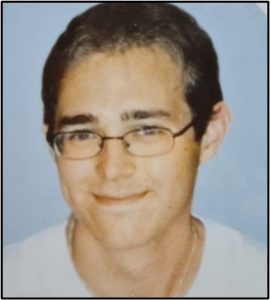Please note that some of these case studies were also in our press packs, which can be found under the heading ‘Information’.
 Susan Henry – Deceased in 2018
Susan Henry – Deceased in 2018
Click here to view full case study
Age: 66
Fuel: Solid fuel
Appliance & Location: Wood-burning stove in her home
Notes by CO-Gas Safety: This case study is written by Susan’s daughter, also called Susan. Thankfully, another of Susan’s daughters survived this incident, as did her husband, although his health is still affected by his exposure to carbon monoxide. The family pets alerted them to the fumes that were spreading through the house and undoubtedly saved two lives, but a carbon monoxide alarm and greater knowledge of the dangers of CO would almost certainly have prevented this tragedy. We are extremely grateful to Susan’s family for their work on this account so soon after such a deep loss.
 Ken Jeffery – Deceased in 2017
Ken Jeffery – Deceased in 2017
Click here to view full case study
Age: 73
Fuel: Petrol
Appliance & Location: Engine of his own boat
Notes by CO-Gas Safety: This case study is written by Ken’s wife, Margaret Jeffery. This case is not held within our statistical database, as Ken lived and died on the Island of Jersey, which is outside our geographical remit. However, Ken’s family wish to do all they can to raise awareness and CO-Gas Safety recognise the importance of this tragic example.
 Nikki Willis – Deceased in 2016
Nikki Willis – Deceased in 2016
Click here to view full case study
Age: 23
Fuel: Petrol
Appliance & Location: Car engine and exhaust system
Notes by CO-Gas Safety: This case study is written by Nikki’s mother, Michelle Hindson, and was published in our 2019 press pack. The fact that petrol and diesel engines produce carbon monoxide is too often overlooked. This car was parked in the open, not in an enclosed space, but modifications to the exhaust system had fatal consequences.
 Tom Hill – Deceased in 2015
Tom Hill – Deceased in 2015
Click here to view full case study
Age: 18
Fuel: Butane gas cylinder
Appliance & Location: Portable cabinet heater in a rented holiday cottage
Notes by CO-Gas Safety: Tom’s parents have generously written this account of the tragedy that killed their son while he was on holiday in Scotland. A portable gas heater was found to be at fault but the main concern they have is to make people aware of how serious it can be if a carbon monoxide alarm sounds, and what action to take if one does. Never ignore one or assume it is faulty.
 Francesca Dingley – Deceased in 2015
Francesca Dingley – Deceased in 2015
Click here to view full case study
Age: 22
Fuel: Mains gas
Appliance & Location: Water heater in rented apartment in China
Notes by CO-Gas Safety: This case study is written by Francesca’s father, Mark Dingley. The investigation into his daughter’s death was very much complicated by the fact that it happened abroad, in accommodation arranged by her employer. Francesca and her flatmate, who was seriously injured in the incident, did not have a carbon monoxide alarm or detector and such incidents are probably more common in China and many other countries.
 Kimberley Jones – Deceased in 2013
Kimberley Jones – Deceased in 2013
Click here to view full case study
Age: 25
Fuel: Solid
Appliance & Location: Multi-fuel burner in her new home
Notes by CO-Gas Safety: The Trianco multi-fuel heater in this property was emitting carbon monoxide as its flueways had not been cleaned before being used.
 Kelly Webster & Lauren Thornton – Deceased in 2013
Kelly Webster & Lauren Thornton – Deceased in 2013
Click here to view full case study
Ages: 36 & 10
Fuel: Petrol
Appliance & Location: Portable generator used on board a boat
Notes by CO-Gas Safety: This case study was written by Kelly’s sister, Tracy, and was published in the 2018 press pack. CO-Gas Safety are very grateful to Tracy for her support. CO poisoning on board boats continues to be an underrated risk, with a further 9 deaths on boats having been recorded by us since this tragedy at time of writing. Petrol is often not associated with carbon monoxide but any combustible fuel can produce CO, in any location.
 Pauline Croxall – Deceased in 2012
Pauline Croxall – Deceased in 2012
Click here to view full case study
Age: 72
Fuel: Diesel
Appliance & Location: Generator in the porch of her mobile home
Notes by CO-Gas Safety: This account was transcribed by Stephanie Trotter on 13.12.18 from Pauline’s sister, Karen Barlow. It appeared in our 2018 press pack and shows that CO alarms are only effective if we realise why they activate and what appliances, fuels and conditions can produce a build up of carbon monoxide. It is also essential to find the source of the CO. In this case Pauline assumed the source of CO was from the gas fire when the CO was actually being emitted by the generator in the porch of her mobile home.
 Matthew Nixon – Deceased in 2010
Matthew Nixon – Deceased in 2010
Click here to view full case study
Age: 22
Fuel: Petrol
Appliance & Location: Portable generator used while working
Notes by CO-Gas Safety: Matthew was a Gas Safe Registered installer who was using a petrol-powered portable generator in an enclosed space while working in a vacant flat. This fatality made it clear to CO-Gas Safety that even those trained in working with gas may not be sufficiently aware of the dangers of CO from gas and other fuels, and that both more training and more equipment were needed.
 Ben Kuchta – Witness to a fatality in 2009
Ben Kuchta – Witness to a fatality in 2009
Click here to view full case study
Age: 19
Fuel: Mains gas
Appliance & Location: Central heating boiler in customer’s home
Notes by CO-Gas Safety: Ben is not only a Gas Safe Registered engineer but also an entrepreneur and inventor of the award-winning Project SOTER cutoff device. Here he tells of the unintentional carbon monoxide poisoning incidents he has been witness to, including a fatal one when he was a young apprentice.
 Fred Jackson – Deceased in 2008
Fred Jackson – Deceased in 2008
Click here to view full case study
Age: 52
Fuel: Mains gas
Appliance & Location: Central heating boiler in a hotel
Notes by CO-Gas Safety: Fred’s daughter, Emma, has written this case study for us, for which we are very grateful. It is a reminder that carbon monoxide poisoning can often be mistaken for common viruses, such as flu or Covid-19. If Fred had taken a portable CO alarm with him on his business trip then he may have survived. Two contractors responsible for designing and fitting the flue of the hotel boiler near Fred’s hotel window were found guilty of breaching gas safety regulations and sentenced to fines.
 Angela Pinkney – Deceased in 2005
Angela Pinkney – Deceased in 2005
Click here to view full case study
Age: 35
Fuel: Mains gas
Appliance & Location: Central heating boiler in her rented home
Notes by CO-Gas Safety: This case study is written by Angela’s older brother, Michael. Angela’s case is one where, sadly, despite the landlady being diligent in attempting to maintain the boiler safely, mistakes were made by qualified professionals. Not only did the boiler receive sub-standard care from engineers, but also Angela herself visited her local hospital with symptoms the day before she died and carbon monoxide poisoning was not diagnosed by staff there.
 Katie Overton – Deceased in 2003
Katie Overton – Deceased in 2003
Click here to view full case study
Age: 11
Fuel: Mains gas
Appliance & Location: Central heating boiler in her rented home
Notes by CO-Gas Safety: The 2018 CO-Gas Safety press pack included Katie’s story told by her father, Paul Overton, who has been a trustee and director of CO-Gas Safety since 2005. In 2019 her sister Sian wanted to provide us with an account of the impact Katie’s death had on her and her family, and also support our call for changes to the Gas Safety Regulations. We are very grateful to her for this personal account.
 Katie Overton – Deceased in 2003
Katie Overton – Deceased in 2003
Click here to view full case study
Age: 11
Fuel: Mains gas
Appliance & Location: Central heating boiler in her rented home
Notes by CO-Gas Safety: This description of the incident that resulted in the death of Katie Overton, and the weeks following it, was told to Stephanie Trotter of CO-Gas Safety by Katie’s stepfather, Paul. All of the Overton family could so easily have been killed by CO, as they returned to their rented home without knowing the boiler had been the cause of Katie’s death. This case validates the simple measures that CO-Gas Safety are still campaigning for to prevent future tragedies.
 Michael Frosdick- Deceased in 2003
Michael Frosdick- Deceased in 2003
Click here to view full case study
Age: 19
Fuel: Mains gas
Appliance & Location: Living room fire in his rented shared flat
Notes by CO-Gas Safety: This account of the devastation that Michael’s death had on his family was kindly written for us by Michael’s older brother, Andrew. Two men pleaded guilty to the manslaughter of Michael and his friend; they were sentenced to five and three years in prison as a result. The landlord continued renting several properties after his release and was fined in 2015 for further safety failings, such as electrics and fire safety.
 Edna Lawrence – Deceased in 1996
Edna Lawrence – Deceased in 1996
Click here to view full case study
Age: 70
Fuel: Solid fuel
Appliance & Location: Boiler for hot water, in her own home
Notes by CO-Gas Safety: The number of unintentional deaths caused by carbon monoxide poisoning may be even higher than our figures suggest. We believe that it is highly possible that a number of deaths are not diagnosed as CO-related due to a lack of awareness among those involved in the recording of the death. This may be the case for elderly victims in particular, where other ‘natural causes’ of death may be more readily assumed. In this case, a heart attack was initially thought to be the medical cause of death.
 Anne Brennan – Deceased in 1995
Anne Brennan – Deceased in 1995
Click here to view full case study
Age: 20
Fuel: Mains gas
Appliance & Location: Central heating boiler in a student house
Notes by CO-Gas Safety: Anne’s death was the catalyst that caused CO-Gas Safety to recommend that the public only buy and install CO detectors with audible alarms to British Standard, later EN 50291. At the time, disposable detector indicators that changed colour when exposed to CO (black spot detectors) were in wider use. These seemed cheaper, but weren’t over a longer period, and obviously couldn’t rouse victims from sleep or a CO-induced stupor.



